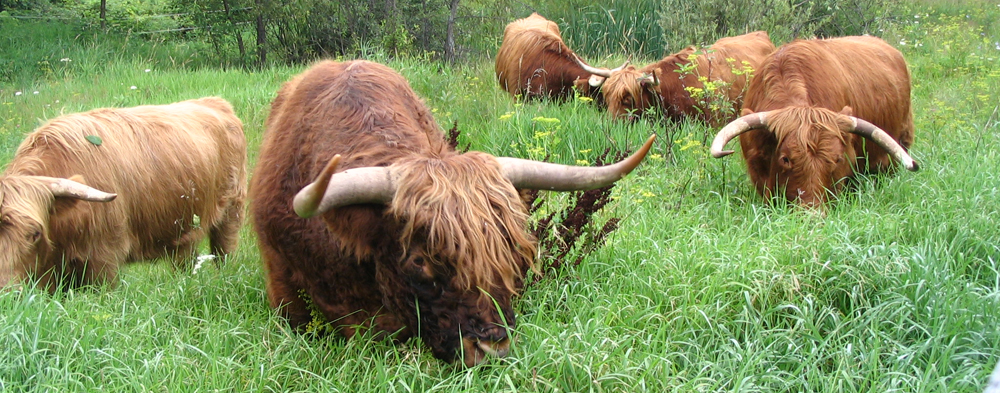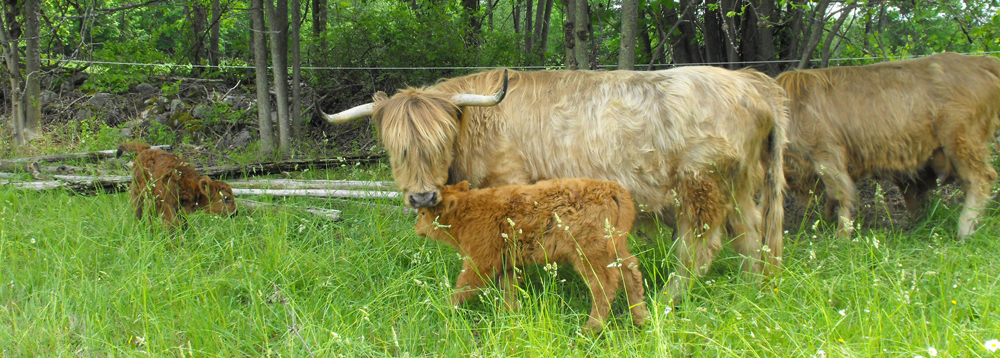Earth Haven's Scottish Highland Fold
We acquired ten purebred heifers in the fall of 2007 and then purchased our first herd sire in the late spring of 2008, with our first calf born in 2009. Thus, the beginnings of our highland fold (a herd of Scottish Highland Cattle is called a fold).
The Scottish Highland Cattle have proven to be everything that is written and said about them. Our research into the history and characteristics of the breed indicated that they would be a good match to the type of farm we had to work with, the landscape, the weather, and our plans for integrating biodynamic agricultural practices.

They quickly came together and formed a very strong bond as a herd. As much as they have their herd hierarchy, they look out for each other and not one is ever left behind. Our property is adjacent to 3,000 acres of conservation land with everything from coyotes, wolves, bears, fox, deer, weasels, skunks, porcupines and stray dogs wondering through. They wonder free with little incidence of predators.
Having purchased property that was not worked for well over six years, cattle have served to push back the intrusion of the forests into the fields, which in some areas has been as much as fifteen feet. The two wooded pastures which were almost completely impassible due to scrub growth have been restored to a state whereby sunshine and rain are able to penetrate the foliage growth and grasses have returned thus providing natural forage for the animals. The canopy has been naturally pruned by the cattle and there is a relationship between the two. The wooded pasture area is actually one of their most favorite places to be.
The herd has shown themselves to be hardy foragers at best, with pallets not only for grasses, clover and alfalfa, but they munch down on prickly ash, apple, golden rod, thistle, wild parsnip, sumac, and wide variety of wild plants.
Just as the experts on the breed mention, they do use their horns just like we would use our fingers. They are well aware of how to use and manipulate their horns, both gently and at times effectively. The rare moment of aggression within the herd is usually a brief head bashing, following by one backing off in submission.
Our barn is old with little shelter from the cold or protection from predators. Again, a reason why we chose this breed. In minus thirty degree winter conditions they stand outside in the blustery winter weather huddled together like husky dogs in the arctic north. Their thick shaggy coats and hair over their eyes are definitely an asset, especially in our northern climate.
They are easy-going in nature, exceptionally easy to move and manage from one pasture to another, and naturally prefer pasture greens to grains, sweet feeds, and treats. Our herd is moved from one pasture area to another on a regular rotation, with access to water and natural shade in all areas. They have to walk to and from the barn for water and thus get ample exercise.
The meat is muscular with little fat. The taste is sweet and extremely nutritious. We have been able to reduce our meat consumption more than half in all recipes and feel full, satisfied and energized. Our personal experience tells us that the meat is everything that it should be and more.
We believe that our herd are happy, content and are being raised in an environment that allows them to be what they came into this world to be, and are able to be the best that they can be.



